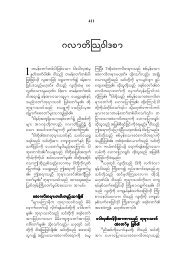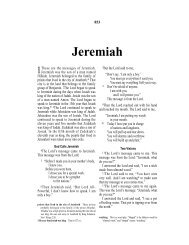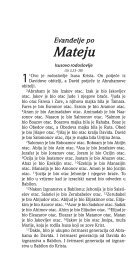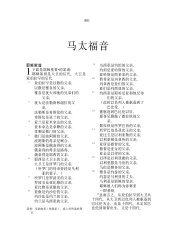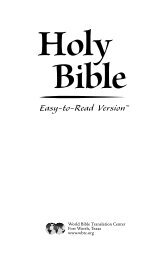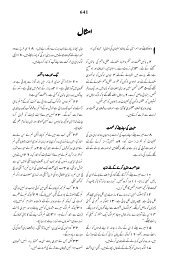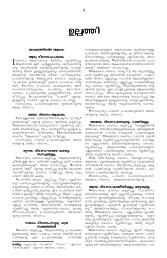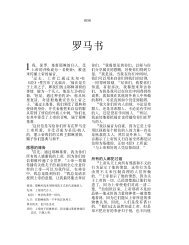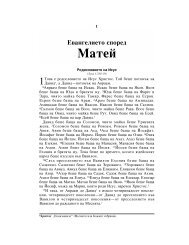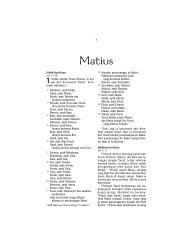English Version for the Deaf
English Version for the Deaf
English Version for the Deaf
You also want an ePaper? Increase the reach of your titles
YUMPU automatically turns print PDFs into web optimized ePapers that Google loves.
Holy<br />
Bible<br />
<strong>English</strong> <strong>Version</strong><br />
<strong>for</strong> <strong>the</strong> <strong>Deaf</strong><br />
Translated from <strong>the</strong><br />
original languages<br />
World Bible Translation Center, Inc.<br />
Fort Worth,Texas
Holy Bible: <strong>English</strong> <strong>Version</strong> <strong>for</strong> <strong>the</strong> <strong>Deaf</strong><br />
© Copyright 2003 World Bible Translation Center<br />
All rights reserved<br />
This copyrighted material may be quoted up to 1000 verses without written permission.<br />
However, <strong>the</strong> extent of quotation must not comprise a complete book nor<br />
should it amount to more than 50% of <strong>the</strong> work in which it is quoted. This copyright<br />
notice must appear on <strong>the</strong> title or copyright page:<br />
Taken from <strong>the</strong> Holy Bible: <strong>English</strong> <strong>Version</strong> <strong>for</strong> <strong>the</strong> <strong>Deaf</strong> (EVD)<br />
© 2003 by World Bible Translation Center, Inc. and used by permission.<br />
When quotations from <strong>the</strong> EVD are used in non-saleable media, such as church<br />
bulletins, orders of service, posters, transparencies or similar media, a complete<br />
copyright notice is not required, but <strong>the</strong> initials (EVD) must appear at <strong>the</strong> end of each<br />
quotation.<br />
Requests <strong>for</strong> permission to use quotations or reprints in excess of 1000 verses or<br />
more than 50% of <strong>the</strong> work in which <strong>the</strong>y are quoted, or o<strong>the</strong>r permission requests,<br />
must be directed to and approved in writing by World Bible Translation Center, Inc.<br />
World Bible Translation Center, Inc.<br />
P.O. Box 820648<br />
Fort Worth, Texas 76182-0648<br />
bibles@wbtc.com<br />
Download free electronic copies of<br />
World Bible Translation Center’s Bibles<br />
and New Testaments at:<br />
www.wbtc.org<br />
ISBN Cover<br />
1-932438-15-7 Flexcover<br />
1-932438-16-5 Hardcover<br />
If you have received this Bible as a gift, it has been provided<br />
through <strong>the</strong> generosity of friends and partners of World Bible<br />
Translation Center. World Bible Translation Center exists to<br />
translate and distribute easy-to-read editions of God’s Word in<br />
<strong>the</strong> world’s major languages. If you have purchased this Bible,<br />
you will be glad to know that a portion of <strong>the</strong> purchase price<br />
has gone to send God’s Word to people around <strong>the</strong> world.<br />
If you would like to give additional support to World Bible<br />
Translation Center, you may send it to <strong>the</strong> address on this page.
Contents<br />
Preface v<br />
Introduction vii<br />
Old Testament<br />
Genesis 1<br />
Exodus 60<br />
Leviticus 113<br />
Numbers 152<br />
Deuteronomy 203<br />
Joshua 247<br />
Judges 276<br />
Ruth 309<br />
1 Samuel 314<br />
2 Samuel 354<br />
1 Kings 388<br />
2 Kings 426<br />
1 Chronicles 465<br />
2 Chronicles 504<br />
Ezra 549<br />
Nehemiah 562<br />
Es<strong>the</strong>r 581<br />
Job 591<br />
Psalms 630<br />
Proverbs 728<br />
Ecclesiastes 755<br />
Song of Solomon 766<br />
Isaiah 774<br />
Jeremiah 853<br />
Lamentations 942<br />
Ezekiel 951<br />
Daniel 1015<br />
Hosea 1035<br />
Joel 1047<br />
Amos 1052<br />
Obadiah 1062<br />
Jonah 1064<br />
Micah 1067<br />
Nahum 1076<br />
Habakkuk 1080<br />
Zephaniah 1084<br />
Haggai 1088<br />
Zechariah 1091<br />
Malachi 1102<br />
New Testament<br />
Mat<strong>the</strong>w 1109<br />
Mark 1156<br />
Luke 1185<br />
John 1232<br />
Acts 1265<br />
Romans 1311<br />
1 Corinthians 1330<br />
2 Corinthians 1347<br />
Galatians 1358<br />
Ephesians 1365<br />
Philippians 1372<br />
Colossians 1377<br />
1 Thessalonians 1382<br />
2 Thessalonians 1386<br />
1 Timothy 1389<br />
2 Timothy 1395<br />
Titus 1399<br />
Philemon 1402<br />
Hebrews 1403<br />
James 1419<br />
1 Peter 1424<br />
2 Peter 1430<br />
1 John 1434<br />
2 John 1439<br />
3 John 1440<br />
Jude 1441<br />
Revelation 1443<br />
Maps 1467
Contents<br />
In alphabetical order with abbreviations<br />
Acts Acts 1265<br />
Amos Amos 1052<br />
Colossians Col. 1377<br />
1 Chronicles 1 Chron. 465<br />
2 Chronicles 2 Chron. 504<br />
1 Corinthians 1 Cor. 1330<br />
2 Corinthians 2 Cor. 1347<br />
Daniel Dan. 835<br />
Deuteronomy Deut. 203<br />
Ecclesiastes Ecc. 621<br />
Ephesians Eph. 1365<br />
Es<strong>the</strong>r Es<strong>the</strong>r 581<br />
Exodus Ex. 60<br />
Ezekiel Ezek. 781<br />
Ezra Ezra 549<br />
Galatians Gal. 1358<br />
Genesis Gen. 1<br />
Habakkuk Hab. 1080<br />
Haggai Hag. 1088<br />
Hebrews Heb. 1403<br />
Hosea Hos. 852<br />
Isaiah Isa. 637<br />
James Jas. 1419<br />
Jeremiah Jer. 700<br />
Job Job 591<br />
Joel Joel 1047<br />
John Jn. 1232<br />
1 John 1 Jn. 1434<br />
2 John 2 Jn. 1439<br />
3 John 3 Jn. 1440<br />
Jonah Jonah 1064<br />
Joshua Josh. 247<br />
Jude Jude 1441<br />
New Testament books are in italics.<br />
Judges Judges 276<br />
1 Kings 1 Kings 388<br />
2 Kings 2 Kings 426<br />
Lamentations Lam. 774<br />
Leviticus Lev. 113<br />
Luke Lk. 1185<br />
Malachi Mal. 1102<br />
Mark Mk. 1156<br />
Mat<strong>the</strong>w Mt. 1109<br />
Micah Micah 1067<br />
Nahum Nahum 1076<br />
Nehemiah Neh. 562<br />
Numbers Num. 152<br />
Obadiah Obad. 1062<br />
1 Peter 1 Pet. 1424<br />
2 Peter 2 Pet. 1430<br />
Philemon Phm. 1402<br />
Philippians Php. 1372<br />
Proverbs Prov. 599<br />
Psalms Ps. 519<br />
Revelation Rev. 1443<br />
Romans Rom. 1311<br />
Ruth Ruth 309<br />
1 Samuel 1 Sam. 314<br />
2 Samuel 2 Sam. 354<br />
Song of Solomon S. of S. 630<br />
1 Thessalonians 1 Th. 1382<br />
2 Thessalonians 2 Th. 1386<br />
1 Timothy 1 Tim. 1389<br />
2 Timothy 2 Tim. 1395<br />
Titus Titus 1399<br />
Zechariah Zech. 1091<br />
Zephaniah Zeph. 1084<br />
All Scripture is given by God. And all Scripture is useful <strong>for</strong> teaching and <strong>for</strong> showing<br />
people <strong>the</strong> things that are wrong in <strong>the</strong>ir lives. It is useful <strong>for</strong> correcting faults and<br />
teaching how to live right.<br />
2 Timothy 3:16
v<br />
Preface<br />
This version of <strong>the</strong> Bible has been prepared especially <strong>for</strong> people who are<br />
deaf. It is important that everyone have <strong>the</strong> Bible in a language <strong>the</strong>y understand.<br />
But existing <strong>English</strong> versions do not meet <strong>the</strong> special needs of most<br />
deaf people, because <strong>the</strong> deaf have not had <strong>the</strong> advantage of constant exposure<br />
to <strong>the</strong> spoken language in developing <strong>the</strong>ir knowledge and usage of<br />
<strong>English</strong>.<br />
The <strong>English</strong> <strong>Version</strong> <strong>for</strong> <strong>the</strong> <strong>Deaf</strong> is not a revision of any <strong>English</strong> version<br />
designed <strong>for</strong> <strong>the</strong> hearing. It is an original translation based on <strong>the</strong> Hebrew<br />
and Greek Biblical texts. The wording will often strike <strong>the</strong> reader as different<br />
from o<strong>the</strong>r <strong>English</strong> translations, but it accurately expresses <strong>the</strong> full<br />
meaning of <strong>the</strong> original text in a style that is clear and easy to understand.<br />
The writers of Scripture, especially those who produced <strong>the</strong> New Testament<br />
writings, showed by <strong>the</strong> common language style <strong>the</strong>y used that <strong>the</strong>y were<br />
interested in good communication. The translators of this <strong>English</strong> version<br />
considered <strong>the</strong>ir example to be an important one to follow. So <strong>the</strong>y worked<br />
to express <strong>the</strong> meaning of <strong>the</strong> Biblical text in a <strong>for</strong>m that would be simple<br />
and natural. They used language that would not be a hindrance to understanding,<br />
but would provide a key to unlock <strong>the</strong> truths of Scripture <strong>for</strong><br />
people whose experience with <strong>English</strong> has been limited.<br />
Although <strong>the</strong> full meaning of <strong>the</strong> original text is expressed in <strong>the</strong> translation,<br />
<strong>the</strong> sense of <strong>the</strong> original has been restructured into <strong>the</strong> closest natural<br />
equivalents in <strong>English</strong> <strong>for</strong> <strong>the</strong> deaf community. For example, pronouns such<br />
as "he," "she," and "<strong>the</strong>y" are usually replaced with proper names, as is <strong>the</strong><br />
practice in sign language. Many common idioms used in spoken <strong>English</strong> are<br />
avoided, such as, "They got mad," which might be expressed instead as<br />
"They became angry." The result is an <strong>English</strong> translation that communicates<br />
more effectively to <strong>the</strong> deaf.<br />
The use of <strong>English</strong> was, of course, a practical necessity. But great care was<br />
taken to speak primarily to <strong>the</strong> deaf and not to <strong>the</strong> hearing. With <strong>the</strong> help of<br />
consultants familiar with deaf communication patterns, <strong>the</strong> translators<br />
attempted to match those patterns in <strong>English</strong> as closely as possible. They<br />
also benefited from testing done in different regions of <strong>the</strong> United States to<br />
determine a vocabulary familiar to most deaf readers.<br />
The result might appear to be just a simple <strong>English</strong> version of <strong>the</strong> Bible, but
PREFACE vi<br />
is much more than that. It is a carefully constructed translation, designed to<br />
communicate to those who are deaf. Although <strong>the</strong> language used will not be<br />
familiar to those accustomed to standard <strong>English</strong> versions, it does convey to<br />
<strong>the</strong> deaf <strong>the</strong> meaning that was originally intended.<br />
It is <strong>the</strong> purpose of this translation to provide <strong>the</strong> deaf with <strong>the</strong>ir own Bible<br />
<strong>for</strong> personal reading and study and to aid <strong>the</strong> vital ministry of those who<br />
teach <strong>the</strong> deaf, giving <strong>the</strong>m relief from <strong>the</strong> need to "translate" existing<br />
<strong>English</strong> versions as <strong>the</strong>y teach.<br />
The translation is based directly on <strong>the</strong> original languages of Scripture. In<br />
<strong>the</strong> case of <strong>the</strong> Old Testament, <strong>the</strong> translators followed <strong>the</strong> Hebrew<br />
Masoretic Text as it is found in <strong>the</strong> latest printed edition of Biblia Hebraica<br />
Stuttgartensia (1984), while referring occasionally to some earlier readings<br />
in <strong>the</strong> Dead Sea Scrolls. In some cases, <strong>the</strong>y also followed <strong>the</strong> Septuagint<br />
(LXX), <strong>the</strong> Greek translation of <strong>the</strong> Old Testament, where it has readings<br />
that are actually earlier than any known Hebrew manuscript. For <strong>the</strong> New<br />
Testament, <strong>the</strong> source text was that which is found in both <strong>the</strong> United Bible<br />
Societies' Greek New Testament (third edition, 1975 and fourth revised edition,<br />
1993) and <strong>the</strong> Nestle-Aland Novum Testamentum Graece (twenty-seventh<br />
edition, 1993). The occasional variation from <strong>the</strong>se printed editions<br />
was guided by reference to <strong>the</strong> findings of more recent scholarship.<br />
Several special features are used to aid understanding. Brief explanations or<br />
synonyms (italicized within paren<strong>the</strong>ses) sometimes follow difficult or<br />
ambiguous words in <strong>the</strong> text. Words or phrases that need fuller explanation<br />
are followed by an asterisk (*) and explained in footnotes at <strong>the</strong> bottom of<br />
<strong>the</strong> page. In addition, footnotes often identify Scripture quotations or give<br />
alternate readings when significant differences occur in <strong>the</strong> ancient<br />
manuscripts.<br />
As in all translations, words that are implied by <strong>the</strong> context are often supplied<br />
in <strong>the</strong> text to make <strong>the</strong> meaning clear. For example, <strong>the</strong> phrase that in<br />
Greek is simply "David of Jesse" is always translated into <strong>English</strong> as<br />
"David <strong>the</strong> son of Jesse." If such explanatory words or phrases are extensive<br />
or unusual, <strong>the</strong>y may be marked by half brackets. For example, in <strong>the</strong> translation,<br />
"The Lord gave this command to Moses {<strong>for</strong> <strong>the</strong> people}," <strong>the</strong> phrase<br />
in half brackets is added to avoid any misunderstanding that <strong>the</strong> Lord's command<br />
was intended only <strong>for</strong> Moses and not <strong>for</strong> all <strong>the</strong> people.<br />
Finally, in <strong>the</strong> Gospels, <strong>the</strong> first four books of <strong>the</strong> New Testament, <strong>the</strong> section<br />
headings are often followed by cross references. These identify where<br />
<strong>the</strong> same or similar material is found in one or more of <strong>the</strong> o<strong>the</strong>r Gospels.
vii<br />
Introduction<br />
The word Bible comes from a Greek word meaning “books.” The Bible is actually<br />
two collections of books, often referred to as <strong>the</strong> “Old Testament” and <strong>the</strong> “New<br />
Testament.” The word translated “testament” was used to mean a covenant or agreement.<br />
It refers to God’s promise to bless his people. The Old Testament is <strong>the</strong> collection<br />
of writings that relate to <strong>the</strong> agreement that God made with <strong>the</strong> descendants of<br />
Jacob (Israel) in <strong>the</strong> time of Moses. The New Testament is <strong>the</strong> collection of writings<br />
that relate to <strong>the</strong> agreement God made with all people who believe in Jesus Christ.<br />
The Old Testament writings tell about <strong>the</strong> great things God did <strong>for</strong> <strong>the</strong> people of<br />
Israel and his plan <strong>for</strong> using <strong>the</strong>m to bring his blessings to <strong>the</strong> whole world. These<br />
writings look <strong>for</strong>ward to <strong>the</strong> coming of a savior or “Messiah” (see “Christ” in <strong>the</strong><br />
Word List). The New Testament writings continue <strong>the</strong> Old Testament story. They<br />
describe <strong>the</strong> coming of that savior (Jesus Christ) and <strong>the</strong> meaning of his coming <strong>for</strong><br />
all people. The Old Testament is important <strong>for</strong> understanding <strong>the</strong> New Testament,<br />
since it provides <strong>the</strong> necessary background. And <strong>the</strong> New Testament completes <strong>the</strong><br />
story of salvation that began in <strong>the</strong> Old Testament.<br />
THE OLD TESTAMENT<br />
The Old Testament writings are a collection of thirty-nine different books produced<br />
by many different authors. They were written mainly in Hebrew, <strong>the</strong> language of<br />
ancient Israel. There are a few sections in Aramaic, an international language in<br />
Bible times. Portions of <strong>the</strong> Old Testament were written over 3500 years ago, and<br />
more than 1000 years passed between <strong>the</strong> writing of <strong>the</strong> first book and <strong>the</strong> last. In this<br />
collection <strong>the</strong>re are books of law, history, prose, songs, poetry, and wise sayings.<br />
The Old Testament is often divided into three main sections: <strong>the</strong> Law, <strong>the</strong> Prophets,<br />
and <strong>the</strong> Holy Writings. The Law contains five books called “The Five Books of<br />
Moses.” The first book is Genesis. It tells about <strong>the</strong> beginning of <strong>the</strong> world as we<br />
know it, <strong>the</strong> first man and woman, and <strong>the</strong>ir first sin against God. It tells about <strong>the</strong><br />
Great Flood and <strong>the</strong> family God saved through that flood, and it tells about <strong>the</strong><br />
beginnings of <strong>the</strong> nation of Israel, <strong>the</strong> people God chose to use <strong>for</strong> a special purpose.<br />
THE STORY OF ABRAHAM<br />
God made an agreement with Abraham, a great man of faith. In that agreement God<br />
promised to make Abraham <strong>the</strong> fa<strong>the</strong>r of a great nation and to give him and his<br />
descendants <strong>the</strong> land of Canaan. Abraham was circumcised to show that he had<br />
accepted <strong>the</strong> agreement, and circumcision became <strong>the</strong> proof of <strong>the</strong> agreement<br />
between God and his people. Abraham did not know how God would do what he<br />
had promised but trusted him to make it happen. This pleased God very much.
INTRODUCTION viii<br />
God told Abraham to leave his home in Mesopotamia and led him to Canaan (later<br />
called <strong>the</strong> land of Israel, which was approximately <strong>the</strong> same geographical area<br />
known today as Palestine). In his old age Abraham had a son named Isaac, who had<br />
a son named Jacob. Jacob (also called Israel) had twelve sons and a daughter. This<br />
family became <strong>the</strong> nation of Israel, but it never <strong>for</strong>got its tribal origin. It continued<br />
to refer to itself as <strong>the</strong> twelve tribes of Israel—descendants of <strong>the</strong> twelve sons of<br />
Jacob: Reuben, Simeon, Levi, Judah, Dan, Naphtali, Gad, Asher, Issachar, Zebulun,<br />
Joseph, and Benjamin. The three main ancestors—Abraham, Isaac, and Jacob<br />
(Israel)—are known as <strong>the</strong> “fa<strong>the</strong>rs” or “patriarchs” of Israel.<br />
Abraham was also a “fa<strong>the</strong>r” of ano<strong>the</strong>r kind. Many times in ancient Israel, God<br />
called certain people to speak <strong>for</strong> him. These special people, or prophets, were<br />
God’s representatives to <strong>the</strong> rest of his people. Through <strong>the</strong> prophets God gave <strong>the</strong><br />
people of Israel promises, warnings, laws, teachings, lessons drawn from past<br />
experiences, and lessons based on future events. Abraham “<strong>the</strong> Hebrew” is <strong>the</strong> first<br />
prophet mentioned in <strong>the</strong> Scriptures.<br />
ISRAEL SET FREE FROM SLAVERY<br />
The family of Jacob (Israel) grew to include about 70 of his direct descendants. One<br />
of his sons, Joseph, became a high official in Egypt. Times were hard, so Jacob and<br />
his family moved to Egypt, where <strong>the</strong>re was plenty of food and life was easier. This<br />
tribe of Hebrews grew to be a small nation, and <strong>the</strong> Pharaoh (<strong>the</strong> title or name of <strong>the</strong><br />
king of Egypt) made <strong>the</strong>m serve as slaves. The book of Exodus tells about how<br />
finally, after 400 years, God used <strong>the</strong> prophet Moses to free <strong>the</strong> people of Israel from<br />
slavery and lead <strong>the</strong>m eventually to settle again in Palestine. The price <strong>for</strong> freedom<br />
was high, but <strong>the</strong> Egyptians were <strong>the</strong> ones who had to pay. God punished <strong>the</strong>m with<br />
a series of ten plagues, demanding with each one that his chosen people be set free.<br />
But following each disaster, <strong>the</strong> king stubbornly refused to free <strong>the</strong>m. The final<br />
plague, however, brought about <strong>the</strong> death of <strong>the</strong> firstborn sons of all <strong>the</strong> families of<br />
Egypt, including <strong>the</strong> Pharaoh’s son. This caused <strong>the</strong> king finally to agree to let <strong>the</strong><br />
Israelites go free.<br />
The people of Israel had been given special preparations to make <strong>for</strong> <strong>the</strong>ir trip to<br />
freedom. Dressed and ready <strong>for</strong> <strong>the</strong> escape, each family killed and roasted a lamb.<br />
They put <strong>the</strong> blood from <strong>the</strong> lamb on <strong>the</strong>ir doorposts as a special sign to God. They<br />
hurriedly baked bread without yeast and ate <strong>the</strong>ir meal. That night <strong>the</strong> Angel of <strong>the</strong><br />
Lord went through <strong>the</strong> land. If <strong>the</strong> blood of <strong>the</strong> lamb was not on <strong>the</strong> doorposts, <strong>the</strong><br />
firstborn of that family died. This is why <strong>the</strong> firstborn sons of <strong>the</strong> Egyptians were<br />
put to death, while <strong>the</strong> Angel “passed over” <strong>the</strong> homes of God’s people. This night<br />
and <strong>the</strong> events surrounding it were later remembered in many ways in <strong>the</strong> worship<br />
and sacrifices of <strong>the</strong> people of Israel.<br />
After <strong>the</strong> Israelite slaves were set free and were leaving Egypt, <strong>the</strong> Pharaoh<br />
changed his mind again. He sent his army to catch <strong>the</strong>m and bring <strong>the</strong>m back, but<br />
God saved his people. He divided <strong>the</strong> Red Sea, making a path through it to lead<br />
<strong>the</strong>m to freedom on <strong>the</strong> o<strong>the</strong>r side. Then he released <strong>the</strong> waters to destroy <strong>the</strong> army<br />
of Egyptians that was following <strong>the</strong>m. After Moses led <strong>the</strong> people in a song of<br />
praise to God <strong>for</strong> his protection and kindness, he led <strong>the</strong>m on a long and difficult<br />
journey. Finally, <strong>the</strong>y came to a mountain in <strong>the</strong> desert of Sinai on <strong>the</strong> Arabian<br />
Peninsula, where God made a special agreement with his people.
ix INTRODUCTION<br />
THE LAW OF MOSES<br />
God’s rescue of <strong>the</strong> people of Israel and his agreement with <strong>the</strong>m at Mount Sinai set<br />
this nation apart from all o<strong>the</strong>rs. This agreement contained promises and laws <strong>for</strong><br />
<strong>the</strong> people of Israel. A part of this agreement, known as <strong>the</strong> Ten Commandments,<br />
was written by God on two stone tablets and given to <strong>the</strong> people. These commands<br />
contain <strong>the</strong> basic principles <strong>for</strong> <strong>the</strong> kind of life God wanted <strong>the</strong> people of Israel to<br />
live, including <strong>the</strong>ir duty to God, family, and o<strong>the</strong>rs.<br />
The Ten Commandments and <strong>the</strong> rest of <strong>the</strong> rules and teachings given at Mount<br />
Sinai became known as “<strong>the</strong> Law of Moses” or simply “<strong>the</strong> law.” Many times <strong>the</strong>se<br />
terms are used to refer to <strong>the</strong> first five books of <strong>the</strong> Scriptures and often to <strong>the</strong> entire<br />
Old Testament.<br />
Besides <strong>the</strong> Ten Commandments and o<strong>the</strong>r rules of conduct, <strong>the</strong> Law of Moses contains<br />
rules about priests, sacrifices, worship, and holy days. These rules are found<br />
in <strong>the</strong> book of Leviticus. According to <strong>the</strong> Law of Moses, all priests and <strong>the</strong>ir<br />
helpers came from <strong>the</strong> tribe of Levi. These helpers were called “Levites.” The most<br />
important priest was called <strong>the</strong> high priest.<br />
The Law of Moses included instructions <strong>for</strong> building <strong>the</strong> Holy Tent (“Tabernacle”),<br />
or Meeting Tent, <strong>the</strong> place where <strong>the</strong> people of Israel went to worship God. It also<br />
has instructions <strong>for</strong> making all <strong>the</strong> things to be used in <strong>the</strong>ir worship. This prepared<br />
<strong>the</strong> Israelites <strong>for</strong> <strong>the</strong> building of <strong>the</strong> Temple, <strong>the</strong> holy building in Jerusalem on Mount<br />
Zion, where <strong>the</strong> people would later go to worship God. The rules about sacrifices<br />
and worship <strong>for</strong>ced <strong>the</strong> people to see that <strong>the</strong>y sinned against each o<strong>the</strong>r and against<br />
God. But <strong>the</strong>y also gave <strong>the</strong> people a way to be <strong>for</strong>given and to be reunited with one<br />
ano<strong>the</strong>r and with God. These sacrifices prepared <strong>the</strong> way <strong>for</strong> a better understanding<br />
of <strong>the</strong> sacrifice God was preparing to give <strong>for</strong> all <strong>the</strong> people of <strong>the</strong> world.<br />
The Law of Moses also contained instructions <strong>for</strong> celebrating a number of holy<br />
days or festivals. Each festival had its own special meaning. Some festivals were<br />
happy occasions to celebrate special times of <strong>the</strong> year, especially harvest times.<br />
These included <strong>the</strong> Festival of Weeks and <strong>the</strong> Festival of Shelters in <strong>the</strong> fall. (See<br />
<strong>the</strong>se terms in <strong>the</strong> Word List.)<br />
O<strong>the</strong>r festivals were <strong>for</strong> remembering <strong>the</strong> wonderful things God had done <strong>for</strong> his<br />
people. Passover was this kind of holy day. Each family relived <strong>the</strong> escape from<br />
Egypt, ga<strong>the</strong>ring in <strong>the</strong>ir homes to remember this part of Israel’s history and to sing<br />
songs of praise to God. A lamb was slaughtered and <strong>the</strong> meal prepared. Each cup of<br />
wine and piece of food reminded <strong>the</strong> people of <strong>the</strong> things God had done to save<br />
<strong>the</strong>m from a life of pain and sadness.<br />
One holy day, in particular, was very serious. Every year, on <strong>the</strong> Day of Atonement,<br />
<strong>the</strong> people had to remember <strong>the</strong> many wrong things <strong>the</strong>y had done to o<strong>the</strong>rs and to<br />
God. This was a day of sadness, and <strong>the</strong> people did not eat. But on that day <strong>the</strong> high<br />
priest offered special sacrifices to “cover over” or atone <strong>for</strong> <strong>the</strong>ir sins.<br />
The agreement between God and Israel was very important to <strong>the</strong> writers of <strong>the</strong> Old<br />
Testament. Almost all of <strong>the</strong> books of <strong>the</strong> Prophets and Holy Writings are based on<br />
<strong>the</strong> fact that <strong>the</strong> nation of Israel, and every citizen of Israel, had made a very special<br />
agreement with <strong>the</strong>ir God. They called it <strong>the</strong> “agreement of <strong>the</strong> LORD” or simply
INTRODUCTION x<br />
“<strong>the</strong> agreement.” Their books of history interpret events in light of <strong>the</strong> agreement:<br />
If <strong>the</strong> individual or nation was faithful to God and <strong>the</strong> agreement, <strong>the</strong>n God<br />
rewarded <strong>the</strong>m. If <strong>the</strong> people abandoned <strong>the</strong> agreement, <strong>the</strong>n God punished <strong>the</strong>m.<br />
God sent his prophets to remind <strong>the</strong> people of <strong>the</strong>ir agreement with him. The poets<br />
of Israel sang of <strong>the</strong> wonderful things God did <strong>for</strong> his obedient people, and <strong>the</strong>y<br />
mourned <strong>the</strong> pain and punishments that came to those who disobeyed. These<br />
writers based <strong>the</strong>ir concepts of right and wrong on <strong>the</strong> teaching of <strong>the</strong> agreement.<br />
And when innocent people suffered, <strong>the</strong> poets struggled to understand why.<br />
THE KINGDOM OF ISRAEL<br />
The story of ancient Israel is <strong>the</strong> story of people who were always leaving God,<br />
God rescuing <strong>the</strong> people, <strong>the</strong> people turning back to God and eventually leaving<br />
him again. This cycle began almost as soon as <strong>the</strong> people had accepted God’s<br />
agreement, and it was repeated again and again. At Mount Sinai <strong>the</strong> people of Israel<br />
agreed to follow God, and <strong>the</strong>n <strong>the</strong>y rebelled and were <strong>for</strong>ced to wander 70 years in<br />
<strong>the</strong> desert. Finally, Moses’ helper, Joshua, led <strong>the</strong> people into <strong>the</strong> promised land.<br />
Then came <strong>the</strong> battles to gain control of <strong>the</strong> different areas and settle <strong>the</strong> first parts<br />
of what later came to be known as <strong>the</strong> land of Israel. For <strong>the</strong> first few centuries after<br />
this settlement, <strong>the</strong> people were governed by local leaders called judges.<br />
Eventually, <strong>the</strong> people wanted a king. The first king God appointed <strong>for</strong> <strong>the</strong>m was<br />
Saul. But Saul did not obey God, so God chose a shepherd boy named David to be<br />
<strong>the</strong> new king. The prophet Samuel came and poured oil on his head, anointing him<br />
king of Israel. God promised David that <strong>the</strong> future kings of Israel would be his<br />
descendants from <strong>the</strong> tribe of Judah. David conquered <strong>the</strong> city of Jerusalem and<br />
made it his capital and <strong>the</strong> future site of <strong>the</strong> Temple. He organized <strong>the</strong> priests,<br />
prophets, song writers, musicians, and singers <strong>for</strong> <strong>the</strong> Temple worship. David<br />
even wrote many of <strong>the</strong> songs (or psalms) himself, but God did not let him build<br />
<strong>the</strong> Temple.<br />
When David was old and about to die, with God’s blessing he made his son<br />
Solomon king of Israel. David warned his son to always follow God and obey <strong>the</strong><br />
agreement. As king, Solomon built <strong>the</strong> Temple in Jerusalem that David had<br />
planned, and he expanded Israel’s borders. At this time Israel was at <strong>the</strong> high point<br />
of its power. Solomon became famous, and Israel became strong.<br />
JUDAH AND ISRAEL—THE DIVIDED KINGDOM<br />
At Solomon’s death <strong>the</strong>re was disagreement and a struggle among <strong>the</strong> people, and<br />
<strong>the</strong> nation was divided. The nor<strong>the</strong>rn ten tribes called <strong>the</strong>mselves Israel. The<br />
sou<strong>the</strong>rn tribes called <strong>the</strong>mselves Judah. (The modern term “Jew” comes from this<br />
name.) Judah remained loyal to <strong>the</strong> agreement, and David’s dynasty (family of<br />
kings) continued ruling in Jerusalem <strong>for</strong> several hundred years.<br />
In <strong>the</strong> nor<strong>the</strong>rn kingdom (Israel) numerous kings and dynasties came and went,<br />
because <strong>the</strong> people did not follow <strong>the</strong> agreement. The kings of Israel had several<br />
capital cities at various times, <strong>the</strong> last of which was Samaria. In order to streng<strong>the</strong>n<br />
<strong>the</strong>ir hold on <strong>the</strong> people, <strong>the</strong> kings of Israel changed <strong>the</strong> way to worship God. They<br />
chose new priests and built two new temples—one at Dan (on <strong>the</strong> nor<strong>the</strong>rn border<br />
of Israel) and <strong>the</strong> o<strong>the</strong>r at Be<strong>the</strong>l (along Israel’s border with Judah). There were<br />
many wars between Israel and Judah.
xi INTRODUCTION<br />
During this time of civil war and troubles, God sent many prophets to Judah and<br />
Israel. Some of <strong>the</strong> prophets were priests; o<strong>the</strong>rs were farmers. Some were advisors<br />
to kings; o<strong>the</strong>rs lived a much simpler life. Some of <strong>the</strong> prophets wrote <strong>the</strong>ir teachings<br />
or prophecies; many o<strong>the</strong>rs did not. But all <strong>the</strong> prophets spoke <strong>for</strong> justice, fairness,<br />
and <strong>the</strong> need to depend on God <strong>for</strong> help.<br />
Many prophets warned that <strong>the</strong> people would be defeated and scattered if <strong>the</strong>y did<br />
not turn back to God. Some prophets saw visions of future glories as well as future<br />
punishments. Many of <strong>the</strong>m looked <strong>for</strong>ward to <strong>the</strong> time when a new king would<br />
come to rule <strong>the</strong> kingdom. Some saw this king as a descendant of David who would<br />
lead <strong>the</strong> people of God into a new Golden Age. Some spoke of this king as ruling<br />
<strong>for</strong>ever over an eternal kingdom. O<strong>the</strong>rs saw him as a servant who would suffer<br />
many things in order to bring his people back to God. But all of <strong>the</strong>m saw him as<br />
<strong>the</strong> Messiah, <strong>the</strong> one anointed (chosen) by God to bring in a new age.<br />
THE DESTRUCTION OF ISRAEL AND JUDAH<br />
The people of Israel did not listen to God’s warnings. So in 722/721 B.C. Samaria fell<br />
to <strong>the</strong> invading Assyrians. The people of Israel were taken from <strong>the</strong>ir homes and<br />
scattered throughout <strong>the</strong> Assyrian Empire, lost <strong>for</strong>ever to <strong>the</strong>ir bro<strong>the</strong>rs and sisters<br />
in Judah. Then <strong>the</strong> Assyrians brought in <strong>for</strong>eigners to resettle <strong>the</strong> land of Israel.<br />
These people were taught about <strong>the</strong> religion of Judah and Israel, and many of <strong>the</strong>m<br />
tried to follow <strong>the</strong> agreement. These people came to be known as <strong>the</strong> Samaritans.<br />
The Assyrians tried to invade Judah. Many cities fell to <strong>the</strong> invaders, but God saved<br />
Jerusalem. The defeated king of Assyria returned to his homeland, and <strong>the</strong>re he was<br />
murdered by two of his sons. So Judah was saved.<br />
For a while <strong>the</strong> people of Judah changed. They began to obey God, but only <strong>for</strong> a<br />
short time. They, too, were finally defeated and scattered. The nation of Babylon<br />
rose to power and invaded Judah. At first <strong>the</strong>y took only a few important people<br />
away as captives. But a few years later, in 587/586 B.C., <strong>the</strong>y returned to destroy<br />
Jerusalem and <strong>the</strong> Temple. Some of <strong>the</strong> people escaped to Egypt, but most of <strong>the</strong>m<br />
were taken as slaves to Babylon. Again God sent prophets to <strong>the</strong> people, and <strong>the</strong>y<br />
began to listen. It seems that <strong>the</strong> destruction of <strong>the</strong> Temple and Jerusalem and <strong>the</strong><br />
exile in Babylon brought about a real change in <strong>the</strong> people. The prophets spoke more<br />
and more about <strong>the</strong> new king and his kingdom. One of <strong>the</strong> prophets, Jeremiah, even<br />
spoke of a new agreement—an agreement that would not be written on tablets of<br />
stone, but would be in <strong>the</strong> hearts of God’s people.<br />
THE RETURN TO PALESTINE<br />
Meanwhile, Cyrus came to power over <strong>the</strong> Persian Empire and conquered Babylon.<br />
Cyrus allowed people to return to <strong>the</strong>ir homelands. So after 70 years of exile, many<br />
of <strong>the</strong> people of Judah went back home. The people tried to rebuild <strong>the</strong>ir nation, but<br />
Judah remained small and weak. The people rebuilt <strong>the</strong> Temple, although it was not<br />
as beautiful as <strong>the</strong> one Solomon had built. Many of <strong>the</strong> people truly turned to God<br />
and began studying <strong>the</strong> Law, <strong>the</strong> writings of <strong>the</strong> prophets, and <strong>the</strong> o<strong>the</strong>r holy writings.<br />
Many men became scribes (special scholars), who made copies of <strong>the</strong> Scriptures.<br />
Eventually, <strong>the</strong>se men organized schools <strong>for</strong> studying <strong>the</strong> Scriptures. The<br />
people began meeting toge<strong>the</strong>r on <strong>the</strong> Sabbath (Saturday) to study, pray, and worship<br />
God toge<strong>the</strong>r. In <strong>the</strong>ir synagogues (meetings) <strong>the</strong>y studied <strong>the</strong> Scriptures, and<br />
many people began looking <strong>for</strong> <strong>the</strong> Messiah to come.
INTRODUCTION xii<br />
In <strong>the</strong> West, Alexander <strong>the</strong> Great gained control of Greece and soon conquered <strong>the</strong><br />
world. He spread <strong>the</strong> Greek language as well as <strong>the</strong> customs and culture of Greece<br />
to many parts of <strong>the</strong> world. When he died, his kingdom was divided. Soon ano<strong>the</strong>r<br />
empire grew and gained control of a large part of <strong>the</strong> known world, including Palestine,<br />
where <strong>the</strong> people of Judah lived.<br />
The new rulers, <strong>the</strong> Romans, were often cruel and harsh, and <strong>the</strong> Jewish people were<br />
proud and defiant. In <strong>the</strong>se troubled times <strong>the</strong>re were many Jews who were looking<br />
<strong>for</strong> <strong>the</strong> Messiah to come in <strong>the</strong>ir own lifetime. They wanted to be ruled only by God<br />
and <strong>the</strong> Messiah who God had promised to send <strong>the</strong>m. They did not understand that<br />
God planned to save <strong>the</strong> world through <strong>the</strong> Messiah. They thought that God’s plan<br />
was to save <strong>the</strong> Jews from <strong>the</strong> world! Some were content to wait <strong>for</strong> God to send his<br />
Messiah. O<strong>the</strong>rs thought that <strong>the</strong>y should “help” God establish his new kingdom by<br />
making sure that <strong>the</strong> Law of Moses was observed and that <strong>the</strong> Temple, <strong>the</strong> land, and<br />
<strong>the</strong> Jewish people were kept pure. In order to make this happen, <strong>the</strong>y were willing to<br />
suffer, to die, or to kill anyone, <strong>for</strong>eigners or o<strong>the</strong>r Jews, who threatened <strong>the</strong>se goals.<br />
Such Jews eventually came to be known as “Zealots.”<br />
THE JEWISH RELIGIOUS GROUPS<br />
By <strong>the</strong> first century B.C., <strong>the</strong> Law of Moses had become extremely important to <strong>the</strong><br />
Jews. They had studied and argued over it <strong>for</strong> centuries. The people understood <strong>the</strong><br />
law in different ways, but many Jews were ready to die <strong>for</strong> that law. There were<br />
three major religious groups among <strong>the</strong> Jews, and <strong>the</strong>re were scribes (scholars or<br />
experts in <strong>the</strong> law) in each group.<br />
The Sadducees<br />
One of <strong>the</strong> groups was called <strong>the</strong> Sadducees. This name probably comes from <strong>the</strong><br />
name Zadok, <strong>the</strong> high priest in King David’s time. Many of <strong>the</strong> priests and <strong>the</strong><br />
people in authority were Sadducees. These men accepted only <strong>the</strong> law (<strong>the</strong> five<br />
books of Moses) as <strong>the</strong>ir authority in religious matters. The Law of Moses taught<br />
many things about <strong>the</strong> priests and sacrifices, but it did not teach about life after<br />
death. So <strong>the</strong> Sadducees did not believe that people would ever be raised from death.<br />
The Pharisees<br />
Ano<strong>the</strong>r group was called <strong>the</strong> Pharisees. This name comes from a Hebrew word<br />
meaning “to interpret (explain)” or “to separate.” These men tried to teach or interpret<br />
<strong>the</strong> Law of Moses to <strong>the</strong> common people. The Pharisees believed that <strong>the</strong>re<br />
was an oral tradition going back to Moses’ time. They believed that people of each<br />
generation could interpret <strong>the</strong> law in a way that would allow it to meet <strong>the</strong> needs of<br />
that generation. This meant that <strong>the</strong> Pharisees could accept not only <strong>the</strong> Law of<br />
Moses as <strong>the</strong>ir authority, but also <strong>the</strong> Prophets, <strong>the</strong> Holy Writings, and even <strong>the</strong>ir<br />
own traditions. These men tried very hard to follow <strong>the</strong> law and <strong>the</strong>ir traditions. So<br />
<strong>the</strong>y were very careful about what <strong>the</strong>y ate and what <strong>the</strong>y touched. They were<br />
careful about washing <strong>the</strong>ir hands and bathing. They also believed that people<br />
would be raised from death, because <strong>the</strong>y understood many of <strong>the</strong> prophets to say<br />
that would happen.<br />
The Essenes<br />
The third major group was <strong>the</strong> Essenes. Many of <strong>the</strong> priests in Jerusalem did not<br />
live <strong>the</strong> way God wanted <strong>the</strong>m to. Also, <strong>the</strong> Romans had appointed many of <strong>the</strong><br />
high priests, and some of <strong>the</strong>se men were not qualified according to <strong>the</strong> Law of
xiii INTRODUCTION<br />
Moses. Because of this, <strong>the</strong> Essenes did not think that <strong>the</strong> worship and sacrifices in<br />
<strong>the</strong> Jerusalem Temple were being done properly. So <strong>the</strong>y moved out into <strong>the</strong> Judean<br />
desert to live. They <strong>for</strong>med <strong>the</strong>ir own community, where only o<strong>the</strong>r Essenes could<br />
come and live. They fasted, prayed, and waited <strong>for</strong> God to send <strong>the</strong> Messiah to<br />
purify <strong>the</strong> temple and <strong>the</strong> priesthood. Many scholars believe that <strong>the</strong> Essenes were<br />
connected in some way with <strong>the</strong> Qumran Community and <strong>the</strong> many ancient writings<br />
(including <strong>the</strong> Dead Sea Scrolls) found at Qumran and o<strong>the</strong>r places in that area<br />
of <strong>the</strong> Judean desert.<br />
THE NEW TESTAMENT<br />
God had begun his plan. He had chosen a special nation. He had made an agreement<br />
with those people that would prepare <strong>the</strong>m to understand his justice and his<br />
goodness. Through prophets and poets he had revealed his plan to bless <strong>the</strong> world<br />
by establishing a perfect spiritual “kingdom” based on a new and better agreement.<br />
This plan would begin with <strong>the</strong> coming of <strong>the</strong> promised Messiah. The prophets had<br />
spoken of his coming in great detail. They had told where <strong>the</strong> Messiah would be<br />
born, <strong>the</strong> kind of person he would be, and <strong>the</strong> work he would have to do. It was now<br />
time <strong>for</strong> <strong>the</strong> Messiah to come and begin <strong>the</strong> new agreement.<br />
The part of <strong>the</strong> Bible that is now called <strong>the</strong> New Testament (which means “new<br />
agreement”) describes how God’s new agreement was revealed and put into effect<br />
by Jesus, who was <strong>the</strong> Christ (meaning “<strong>the</strong> Anointed One,” <strong>the</strong> Messiah). This collection<br />
of writings teaches that this agreement was to be <strong>for</strong> all people. And it tells<br />
how people in <strong>the</strong> first century responded to God’s kind offer of love and became a<br />
part of <strong>the</strong> new agreement. The New Testament writings explain how many things<br />
that were part of <strong>the</strong> first agreement are given new meaning under <strong>the</strong> new agreement,<br />
especially ideas related to Israelite worship, such as temple, priesthood, and<br />
sacrifice. These writings give instructions to God’s people about how to live in this<br />
world. They also describe <strong>the</strong> blessings that God promises his people <strong>for</strong> a full and<br />
meaningful life here and <strong>for</strong> life with him after death.<br />
The New Testament writings include twenty-seven different “books” by at least<br />
eight different writers. All of <strong>the</strong>m wrote in Greek, which was widely spoken in <strong>the</strong><br />
first-century world. More than half of <strong>the</strong> total writing was done by four “apostles,”<br />
men chosen by Jesus to be his special representatives or helpers. Three of <strong>the</strong>se,<br />
Mat<strong>the</strong>w, John, and Peter, were among <strong>the</strong> twelve closest followers of Jesus during<br />
his life on earth. The fourth, Paul, was chosen as an apostle later by Jesus through a<br />
miraculous appearance.<br />
The first four books, called “Gospels,” are separate accounts of <strong>the</strong> life and death of<br />
Jesus Christ. Generally, <strong>the</strong>se books emphasize Jesus’ teaching, <strong>the</strong> purpose of his<br />
appearance on earth, and <strong>the</strong> special significance of his death, ra<strong>the</strong>r than just <strong>the</strong><br />
historical facts of his life. This is especially true of <strong>the</strong> fourth book, <strong>the</strong> Gospel of<br />
John. The first three Gospels are very similar in content. In fact, much of <strong>the</strong> material<br />
in one is found in one or both of <strong>the</strong> o<strong>the</strong>rs. There are differing points of<br />
emphasis in each one, however, and each writer seems to have been addressing a<br />
different audience, with perhaps a different goal or goals in view.<br />
The four Gospels are followed by Acts, a history of <strong>the</strong> events following <strong>the</strong> death<br />
of Jesus. It describes how God’s offer of love to all people was announced<br />
throughout <strong>the</strong> world by Jesus’ followers. It tells how <strong>the</strong> proclaiming of this
“gospel” or “Good News” resulted in <strong>the</strong> conversion of thousands of people<br />
throughout Palestine and <strong>the</strong> Roman world to faith in Jesus Christ. The book of<br />
Acts was written by a medical doctor named Luke, an eyewitness of much that he<br />
recorded. Luke was also <strong>the</strong> author of <strong>the</strong> third Gospel. His two books make a logical<br />
unit with Acts being <strong>the</strong> natural sequel to his account of <strong>the</strong> life of Jesus.<br />
Following Acts, <strong>the</strong>re is a collection of letters written to individuals or groups of<br />
believers in Christ. These letters were sent from leaders in <strong>the</strong> faith, such as Paul<br />
and Peter, two of Jesus’ apostles. These letters were written to help <strong>the</strong> people of<br />
that time deal with problems <strong>the</strong>y were facing. They serve to in<strong>for</strong>m, correct, teach,<br />
and encourage not only those people but all who become followers of Jesus in<br />
regard to <strong>the</strong>ir faith, <strong>the</strong>ir life toge<strong>the</strong>r, and <strong>the</strong>ir life in <strong>the</strong> world.<br />
The final book of <strong>the</strong> New Testament, Revelation, is very different from all <strong>the</strong><br />
o<strong>the</strong>rs, although its purpose is similar to that of o<strong>the</strong>r letters to churches. It begins<br />
with words of criticism, encouragement, and instruction addressed to groups of<br />
believers in seven different cities of Asia Minor (modern Turkey). But it continues<br />
with a picture of spiritual warfare that is of interest to all followers of Christ. It uses<br />
highly figurative language and tells of visions seen by <strong>the</strong> author, <strong>the</strong> apostle John.<br />
Many of <strong>the</strong> figures and images are from <strong>the</strong> Old Testament and can best be understood<br />
by comparing <strong>the</strong>m to <strong>the</strong> Old Testament writings. This last book of <strong>the</strong> New<br />
Testament assures believers of ultimate victory over <strong>the</strong> <strong>for</strong>ces of evil through <strong>the</strong><br />
power of God and Jesus Christ, <strong>the</strong>ir leader and helper.<br />
THE BIBLE AND TODAY’S READER<br />
Today’s reader of <strong>the</strong> Bible should keep in mind that <strong>the</strong>se books were written thousands<br />
of years ago <strong>for</strong> people who lived in cultures very different from ours today.<br />
Many of <strong>the</strong> historical accounts, illustrations, and references <strong>the</strong>y contain can only<br />
be understood with some knowledge of <strong>the</strong> time and culture in which <strong>the</strong> writers<br />
lived. Generally, however, <strong>the</strong> writings focus on principles that are universally true.<br />
For example, Jesus told a story about a man sowing grain in a field that had different<br />
types of soil conditions. Those exact conditions may be unfamiliar to a<br />
person today, but <strong>the</strong> lesson Jesus draws from <strong>the</strong> example is appropriate <strong>for</strong> people<br />
in any time or place.<br />
The modern reader may find <strong>the</strong> world of <strong>the</strong> Bible somewhat strange. The customs,<br />
<strong>the</strong> attitudes, and <strong>the</strong> way people talk may be quite unfamiliar. It is only reasonable<br />
to judge <strong>the</strong>se things by <strong>the</strong>ir experience and ideals, not by today’s standards.<br />
It is also important to note that <strong>the</strong> Bible was not written as a book of<br />
science. It was written mainly to describe historical events and present <strong>the</strong> significance<br />
of those events in ways that relate to all people. Its teachings present universal<br />
truths that are beyond <strong>the</strong> realm of science. It remains relevant even in our<br />
own time, because it deals with people’s basic spiritual needs, which never change.<br />
If you read <strong>the</strong> Bible with an open mind, you can expect to receive many benefits.<br />
You will gain knowledge about <strong>the</strong> history and culture of <strong>the</strong> ancient world. You will<br />
learn about <strong>the</strong> life and teachings of Jesus Christ and what it means to be his follower.<br />
You will gain basic spiritual insights and learn practical lessons <strong>for</strong> living a<br />
dynamic and joy-filled life. You will find answers to life’s most difficult questions.<br />
There are, <strong>the</strong>re<strong>for</strong>e, many good reasons <strong>for</strong> reading this book, and if you read it with<br />
a sincere and receptive spirit, you may well discover God’s purpose <strong>for</strong> your life.
License Agreement <strong>for</strong> Bible Texts<br />
World Bible Translation Center<br />
Last Updated: September 21, 2006<br />
Copyright © 2006 by World Bible Translation Center<br />
All rights reserved.<br />
These Scriptures:<br />
• Are copyrighted by World Bible Translation Center.<br />
• Are not public domain.<br />
• May not be altered or modified in any <strong>for</strong>m.<br />
• May not be sold or offered <strong>for</strong> sale in any <strong>for</strong>m.<br />
• May not be used <strong>for</strong> commercial purposes (including, but not limited to, use in advertising or Web banners used<br />
<strong>for</strong> <strong>the</strong> purpose of selling online add space).<br />
• May be distributed without modification in electronic <strong>for</strong>m <strong>for</strong> non-commercial use. However, <strong>the</strong>y may not be<br />
hosted on any kind of server (including a Web or ftp server) without written permission. A copy of this license<br />
(without modification) must also be included.<br />
• May be quoted <strong>for</strong> any purpose, up to 1,000 verses, without written permission. However, <strong>the</strong> extent of<br />
quotation must not comprise a complete book nor should it amount to more than 50% of <strong>the</strong> work in which<br />
it is quoted. A copyright notice must appear on <strong>the</strong> title or copyright page using this pattern: “Taken from<br />
<strong>the</strong> HOLY BIBLE: EASY-TO-READ VERSION © 2006 by World Bible Translation Center, Inc. and used by<br />
permission.” If <strong>the</strong> text quoted is from one of WBTC’s non-<strong>English</strong> versions, <strong>the</strong> printed title of <strong>the</strong> actual text<br />
quoted will be substituted <strong>for</strong> “HOLY BIBLE: EASY-TO-READ VERSION.” The copyright notice must appear<br />
in <strong>English</strong> or be translated into ano<strong>the</strong>r language. When quotations from WBTC’s text are used in non-saleable<br />
media, such as church bulletins, orders of service, posters, transparencies or similar media, a complete copyright<br />
notice is not required, but <strong>the</strong> initials of <strong>the</strong> version (such as “ERV” <strong>for</strong> <strong>the</strong> Easy-to-Read <strong>Version</strong> in <strong>English</strong>)<br />
must appear at <strong>the</strong> end of each quotation.<br />
Any use of <strong>the</strong>se Scriptures o<strong>the</strong>r than those listed above is prohibited. For additional rights and permission <strong>for</strong><br />
usage, such as <strong>the</strong> use of WBTC’s text on a Web site, or <strong>for</strong> clarification of any of <strong>the</strong> above, please contact World<br />
Bible Translation Center in writing or by email at distribution@wbtc.com.<br />
World Bible Translation Center<br />
P.O. Box 820648<br />
Fort Worth, Texas 76182, USA<br />
Telephone: 1-817-595-1664<br />
Toll-Free in US: 1-888-54-BIBLE<br />
E-mail: info@wbtc.com<br />
WBTC’s web site – World Bible Translation Center’s web site: http://www.wbtc.org<br />
Order online – To order a copy of our texts online, go to: http://www.wbtc.org<br />
Current license agreement – This license is subject to change without notice. The current license can be found at:<br />
http://www.wbtc.org/downloads/biblelicense.htm<br />
Trouble viewing this file – If <strong>the</strong> text in this document does not display correctly, use Adobe Acrobat<br />
Reader 5.0 or higher. Download Adobe Acrobat Reader from:<br />
http://www.adobe.com/products/acrobat/readstep2.html<br />
Viewing Chinese or Korean PDFs – To view <strong>the</strong> Chinese or Korean PDFs, it may be necessary to<br />
download <strong>the</strong> Chinese Simplified or Korean font pack from Adobe. Download <strong>the</strong> font packs from:<br />
http://www.adobe.com/products/acrobat/acrrasianfontpack.html



